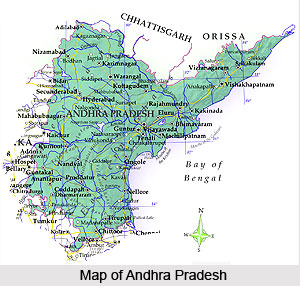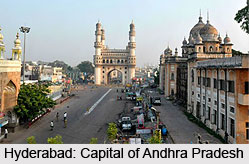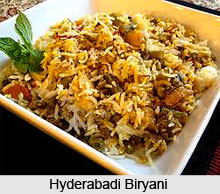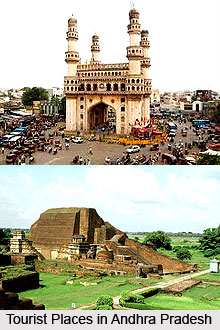 Andhra Pradesh echoes the aura of antiquity through every little aspect of it. The state is vibrant with historical monuments which may be considered as an embodiment of architectural wonder. It has a number of temples, mosques, palaces and is rich in arts, crafts, dance and literature. The stretches of beaches that are present in the state have increased the attractiveness of Andhra Pradesh immensely. Andhra Pradesh is described as the Rice Bowl of India and is also one of the important tourist locations. Hyderabad which is presently known as the technological hub of the country is the capital of Andhra Pradesh.
Andhra Pradesh echoes the aura of antiquity through every little aspect of it. The state is vibrant with historical monuments which may be considered as an embodiment of architectural wonder. It has a number of temples, mosques, palaces and is rich in arts, crafts, dance and literature. The stretches of beaches that are present in the state have increased the attractiveness of Andhra Pradesh immensely. Andhra Pradesh is described as the Rice Bowl of India and is also one of the important tourist locations. Hyderabad which is presently known as the technological hub of the country is the capital of Andhra Pradesh.
History of Andhra Pradesh
Andhra Pradesh has found its mention in Sanskrit epics like the Mahabharata and the Aitareya Brahmana. It is believed by many scholars that Andhra Pradesh had been home to the Dravidians, dark coloured inhabitants. Apart from the reign of the Mauryan dynasty there had been several other dynasties like the Pallavas, the Chalukyas, the Cholas and many others. The Kakatiyas were the feudatories of the Western Chalukyas. Around the year 1323, Ghiaz-ud-din Tughlaq, the Delhi Sultan, had captured the Telugu state and had laid siege to Warangal. Soon after the reign of the Delhi Sultan, Warangal was ruled by Musunuri Nayaks for the next fifty years. By the 18th century, the whole of Andhra Pradesh came under the British rule and it remained under the British rule till the year 1947. Only Hyderabad did not come under British rule. It was still ruled by the Nizams. In 1947, India became independent and Hyderabad became a part of the Republic of India in 1948, as Hyderabad State.
Under the efforts of Amarajeevi Potti Sriramulu, the government was compelled to declare a new state for the Telugu speaking people and a new state named Andhra was formed on 1st October 1953, with Kurnool as its capital. Again on 1st of November 1956, the state of Andhra merged with the Telangana region of Hyderabad State to form the state of Andhra Pradesh. This state also comprised a majority of Telugu speaking people. The capital of the newly formed state was Hyderabad.
Geography of Andhra Pradesh
The geographical position of Andhra Pradesh is between 12 degrees north and 22 degrees north latitude. Longitudinally, the state lies between 77 degrees and 84 degrees east longitude. It is located in the southern part of the Indian subcontinent. In terms of area, it is the fourth largest state in India. As far as the climate of Andhra Pradesh is concerned, the monsoons determine the climatic conditions of the state to a large extent. Summer months in Andhra Pradesh commences from the month of March and continues till June. Major rainfall in the state is witnessed in the months of July to September. Andhra Pradesh receives heavy rainfall from the North-East Monsoon. Winter in Andhra Pradesh begin in November and stays till February.
 Flora of Andhra Pradesh
Flora of Andhra Pradesh
As far as the flora of Andhra Pradesh is concerned, it mostly comprises of dry deciduous mixed types of forest with patches of moist deciduous forests. Trees like Sandalwood, Redsanders, Shorea, Thumbergiana, Shorea talura, Terminalia pallida, Cycas beddomei, Syzygium alternifolium, etc are found in this region. There are almost 1500 plant species belonging to 176 families.
Wildlife of Andhra Pradesh
Wild animals such as Tiger, panther, spotted deer, Sambar, black buck, bison, ibex, sloth bear, pig, bear, Bonnet monkey, mongoose, wild dogs, jackal, fox, wolf, civet cat, jungle cat, rare and endangered golden gecko, Indian giant squirrel, tree shrew, lizards etc are found through out the state. Various species of birds like partridges, quail, peacock, jungle fowl, Crested Serpent Eagle, Ashy Crowned Finch, Lark, Indian Roller, Kingfishers, White bellied Woodpecker and a lot more varieties comprise the varied fauna of Andhra Pradesh.
Districts of Andhra Pradesh
The Indian state of Andhra Pradesh comprises of 13 districts. Previously, Andhra Pradesh had 23 districts. Now after the bifurcation of Andhra Pradesh and the formation of Telangana, Andhra Pradesh includes 13 districts and these districts are governed from Hyderabad, which is the joint capital of both Andhra Pradesh and Telangana. Each district is again subdivided into a number of "mandals" and each "mandal" is basically a collection of villages.
Demographics of Andhra Pradesh
Andhra Pradesh is the fifth largest state in India by area and population. It is the biggest and most populous state in the south of India. The total population of the state is 66,508,854. Out of which the males constitute 33,723,738 and the females constitute to 32,781,116. The literacy rate of the state is 45.11 %. The languages spoken by the people here are Telugu, Urdu, Hindi and Tamil. 84 percent of the population speaks Telugu. English is also used as an official language along with Telugu.
Administration in Andhra Pradesh
 Andhra Pradesh was officially formed in the year 1956. From 1956 till 1958, Andhra Pradesh had a unicameral legislature. 1958 onwards the legislature in Andhra Pradesh had become bi-cameral in nature. But in the year 1985 the bi-cameral form of legislature in Andhra Pradesh was abolished and it once again became unicameral in nature. The unicameral legislature in Andhra Pradesh comprises the Legislative Assembly of the State. At this juncture it may be noted that Andhra Pradesh sends 42 members to the Lower House of Parliament or to the Lok Sabha and 18 members to the Rajya Sabha.
Andhra Pradesh was officially formed in the year 1956. From 1956 till 1958, Andhra Pradesh had a unicameral legislature. 1958 onwards the legislature in Andhra Pradesh had become bi-cameral in nature. But in the year 1985 the bi-cameral form of legislature in Andhra Pradesh was abolished and it once again became unicameral in nature. The unicameral legislature in Andhra Pradesh comprises the Legislative Assembly of the State. At this juncture it may be noted that Andhra Pradesh sends 42 members to the Lower House of Parliament or to the Lok Sabha and 18 members to the Rajya Sabha.
Culture of Andhra Pradesh
The state has a rich cultural heritage. The dance styles in the State are based on the standard treatises, viz. Abhinaya Darpana and Bharatarnava of Nandikeshwara. Kuchipudi is the state`s classical dance form. Along with the dance forms music also contributes to the heritage of the state. The Carnatic Music occupies an important position in the Indian music system. Even the folk songs in the rural areas of Andhra Pradesh add to the rhythm of the country. Telugu literature has also been enriched with the contributions of some great litterateurs. The people of Andhra Pradesh also have a love for movies. The state produces about 200 movies per year.
Andhra Pradesh also celebrates numerous traditional festivals such as Diwali, Holi, Id-Ul-Fitr, Krishna Ashtami, Mahashivratri, Milad-Un-Nabi, Muharram, Dussehra, Christmas, Nagapanchami or Nagula Cahvithi, Sankranthi, RamNavami, Ugadi, VaraLaxmi Vratam, Vinayaka Chavithi.
The cuisine of Andhra Pradesh is known as one of the spiciest Indian cuisine. Rice is the staple food of the state but it can be said that variety is the signature of Andhra Pradesh cuisine. Apart from the mouth watering cuisines Andhra Pradesh is also known for its tasty pickles.
Education of Andhra Pradesh
According to the 2001 census, Andhra Pradesh has a literacy rate of 60.5 percent. The male literacy rate and the female literacy rate are 70.3 percent and 50.4 percent respectively. The student teacher ratio in the fields of higher education in Andhra Pradesh is 1:19. Although the state has 330 Arts, Science and Commerce colleges, 238 Engineering colleges and 53 Medical colleges which offers both bachelors as well as post graduate degrees in various fields including humanities, science, engineering, law, medicine, business and veterinary science. The institutes of prestige in the state are the International Institute of Information Technology (IIIT), Indian School of Business (ISB) and the Osmania University in Hyderabad.

Economy of Andhra Pradesh
Agriculture is the main source of economy in the state. In the recent year, the state has also started focusing on information technology and biotechnology. Hyderabad, the state capital is also known as the drug hub of the country. Almost all the major pharmaceutical companies are present in this state. Other important industries which add to the economy of the country are infrastructure space, mineral resources and certainly hydro-electric power generation. The state ranks first in the national hydro-electric power generation and occupies 11 percent of the market share in the nation. The state is ranked second for it rich mineral resources.
Tourism in Andhra Pradesh
The state of Andhra Pradesh is promoted as the Kohinoor of India by the tourism department of India. It can be said that Andhra Pradesh is a haven for the tourists because they get all they demand within the same state. All kinds of tourism including nature tourism, religious tourism and even historical places of interest are major attractions of the state.
It can be concluded that the state of Andhra Pradesh is varied from all aspects. It is a major tourist attraction of the country and can also be considered as a prime seat of Hindu religious leaders.






